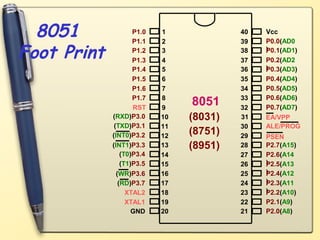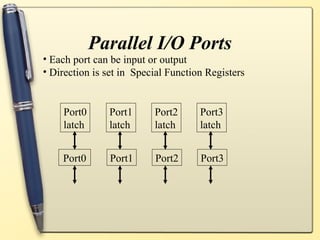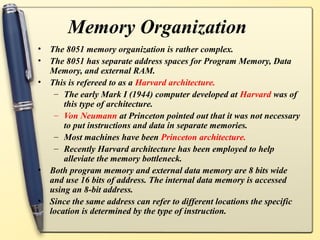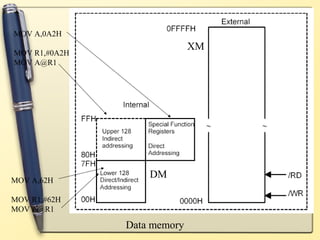8051 MICROCONTROLLER
- 1. The 8051 Microcontroller Prepared By, R-THANDAIAH PRABU M.E., Lecturer - ECE [email protected]
- 2. Disadvantages of microprocessor • The overall system cost is high • A large sized PCB is required for assembling all the components • Overall product design requires more time • Physical size of the product is big • A discrete components are used, the system is not reliable SJCET
- 3. Advantages of Microcontroller based System • As the peripherals are integrated into a single chip, the overall system cost is very less • The product is of small size compared to micro processor based system • The system design now requires very little efforts • As the peripherals are integrated with a microprocessor the system is more reliable • Though microcontroller may have on chip ROM,RAM and I/O ports, addition ROM, RAM I/O ports may be interfaced externally if required • On chip ROM provide a software security SJCET
- 4. Three criteria in Choosing a Microcontroller • meeting the computing needs of the task efficiently and cost effectively – speed, the amount of ROM and RAM, the number of I/O ports and timers, size, packaging, power consumption – easy to upgrade – cost per unit – Noise of environment • availability of software development tools – assemblers, debuggers, C compilers, emulator, simulator, technical support • wide availability and reliable sources of the microcontrollers
- 5. Comparison of the 8051 Family Members • ROM type – 8031 no ROM – 80xx mask ROM – 87xx EPROM – 89xx Flash EEPROM • 89xx – 8951 – 8952 – 8953 – 8955 – 898252 – 891051 – 892051 • Example (AT89C51,AT89LV51) – AT= ATMEL(Manufacture) – C = CMOS technology – LV= Low Power(3.0v)
- 6. Comparison some of the 8051 Family Members ROM RAM Timer 8051 4k 128 2 8031 - 128 2 8751 4k eprom 128 2 8052 8krom 256 3 8032 - 256 3 8752 8k eprom 256 3
- 7. 8051 Basic Component • 4K bytes internal ROM • 128 bytes internal RAM • Four 8-bit I/O ports (P0 - P3). • Two 16-bit timers/counters • One serial interface • 64k external memory for code • 64k external memory for data Microcontroller • 210 bit addressable
- 8. The basic 8051 Core • 8-bit CPU optimized for control applications • Capability for single bit Boolean operations. • Supports up to 64K of program memory. • Supports up to 64K of data memory. • 4 K bytes of on-chip program memory. • Newer devices provide more. • 128 or 256 bytes of on-chip data RAM • Four 8 bit ports. • Two 16-bit timer/counters • UART • Interrupts • On-chip clock oscillator 8
- 9. Block Diagram External interrupts On-chip Timer/Counter Interrupt ROM for On-chip Timer 1 Counter Control program code RAM Timer 0 Inputs CPU Bus Serial 4 I/O Ports OSC Control Port P0 P1 P2 P3 TxD RxD Address/Data
- 10. 8051 Internal Block Diagram
- 12. 8051 P1.0 P1.1 1 2 40 39 Vcc P0.0(AD0 Foot Print P1.2 P1.3 3 4 38 37 ) 0.1(AD1) P P0.2(AD2 P1.4 5 36 ) P0.3(AD3) P1.5 6 35 P0.4(AD4) P1.6 7 34 P0.5(AD5) P1.7 8 33 P0.6(AD6) RST 9 8051 32 P0.7(AD7) (RXD)P3.0 10 (8031) 31 EA/VPP (TXD)P3.1 11 30 ALE/PROG (INT0)P3.2 12 (8751) 29 PSEN (INT1)P3.3 13 (8951) 28 P2.7(A15) (T0)P3.4 14 27 P2.6(A14 (T1)P3.5 15 26 ) P2.5(A13 (WR)P3.6 16 25 ) P2.4(A12 (RD)P3.7 17 24 ) P2.3(A11 XTAL2 18 23 ) P2.2(A10) XTAL1 19 22 P2.1(A9) GND 20 21 P2.0(A8)
- 13. Power-On RESET Circuit Vcc + 10 uF 31 EA/VPP 30 pF X1 19 11.0592 MHz 8.2 K X2 18 30 pF 9 RST
- 14. Port 0 with Pull-Up Resistors Vcc 10 K P0.0 DS5000 P0.1 Port 0 P0.2 8751 P0.3 8951 P0.4 P0.5 P0.6 P0.7
- 15. IMPORTANT PINS (IO Ports) One of the most useful features of the 8051 is that it contains four I/O ports (P0 - P3) Each port can be used as input or output (bi-direction) • Port 0 pins 32-39 ( P0.0 ~ P0.7 ) – 8-bit R/W - General Purpose I/O – Or acts as a multiplexed low byte address and data bus for external memory design
- 16. IMPORTANT PINS (IO Ports) • Port 1 ( pins 1-8 ) ( P1.0 ~ P1.7 ) – Only 8-bit R/W - General Purpose I/O
- 17. IMPORTANT PINS (IO Ports) • Port 2 • ( pins 21-28 ( P2.0 ~ P2.7 ) – 8-bit R/W - General Purpose I/O – Or high byte of the address bus for external memory design
- 18. IMPORTANT PINS (IO Ports) • Port 3 • ( pins 10-17 ( P3.0 ~ P3.7 ) – General Purpose I/O – if not using any of the internal peripherals (timers) or external interrupts.
- 19. Port 3 Alternate Functions
- 20. • ALE - Address latch enable to select valid address • EA/Vpp - External access enable EA-0 execute program in external memory EA-1 execute program in internal memory Vpp it receives 21 V for on chip EPROM PSEN Program store enable store to read the external program memory SJCET
- 21. Registers A B R0 DPTR DPH DPL R1 R2 PC PC R3 R4 Some 8051 16-bit Register R5 R6 R7 Some 8-bitt Registers of the 8051
- 22. Parallel I/O Ports • Each port can be input or output • Direction is set in Special Function Registers Port0 Port1 Port2 Port3 latch latch latch latch Port0 Port1 Port2 Port3
- 24. DPTR • The data pointer consists of a high byte(DPH) and a low byte (DPL). Its function is to hold a 16 bit address. It may be manipulated as a 16 bit data register or two independent 8 bit register. It serves as a base register in indirect jumps, lookup table instructions and external data transfer. SJCET
- 25. PROGRAM STATUS WORD (PSW) CY AC F0 RS1 RS0 OV P RS0 RS1 BANK SELECTION 0 0 00H – 07H BANK0 0 1 08H – 0FH BANK 1 1 0 10H – 17H BANK2 1 1 18H – 1FH BANK 3 SJCET
- 26. Stack in the 8051 7FH • The register used to Scratch pad RAM access the stack is called SP (stack pointer) 30H register. 2FH Bit-Addressable RAM 20H • The stack pointer in the 1FH Register Bank 3 8051 is only 8 bits wide, 18H 17H which means that it can 10H Register Bank 2 take value 00 to FFH. 0FH 08H Stack) Register Bank 1) When 8051 powered up, 07H Register Bank 0 the SP register contains 00H value 07.
- 27. Memory Organization • The 8051 memory organization is rather complex. • The 8051 has separate address spaces for Program Memory, Data Memory, and external RAM. • This is refereed to as a Harvard architecture. – The early Mark I (1944) computer developed at Harvard was of this type of architecture. – Von Neumann at Princeton pointed out that it was not necessary to put instructions and data in separate memories. – Most machines have been Princeton architecture. – Recently Harvard architecture has been employed to help alleviate the memory bottleneck. • Both program memory and external data memory are 8 bits wide and use 16 bits of address. The internal data memory is accessed using an 8-bit address. • Since the same address can refer to different locations the specific location is determined by the type of instruction.
- 28. Program or Code Memory • May consist of internal or external program memory. The amount of internal program memory varies depending on the device. – 4K bytes typical in older devices. – The Silicon Labs C8051F310 contains 16K of flash memory for programs. – The Silicon Labs C8051F020 which is on the University Daughter Card (UDC) contains 4K bytes of program memory. • The MOVC instruction can be use to read code memory. • To reference code memory I will use the notation: CM = CM(0,…,FFFFH) = CM(0,…,FFFFH; 7,…,0) • This notation can be used to specify particular bits and bytes of code memory. For example CM(1234H) refers to the byte of code memory at address 1234H. CM(1234H;7) refers to the most significant bit in that address.
- 29. MOVC A,@A + DPTR ;A ← CM(A+DPTR) MOVC A,@A + PC ;A ← CM(A+PC) CM PC = PC(15..0) DPTR = DPTR(15..0)
- 30. External Memory • Supports up to 64K bytes external memory. – XM(0000,…,FFFF) = XM(0000,…,FFFF; 7,…,0) – Accessed by using the MOVX instruction. • On the original using external memory reduces number of available I/O ports. • On some new devices this is not the case. – For example in C8051F020 64K bytes of external memory has been included in the chip. – The 4 standard 8051 ports are available and three additional ports have been added. MOVX A,@DPTR ;A ← XM(DPTR) MOVX A,@Rn ;A ← XM(P2|Rn) MOVX @DPTR,A ;XM(DPTR) ← A MOVX @Rn,A ;XM(P2|Rn) ← A
- 31. Data Memory • The original 8051 had 128 bytes of on-chip data RAM. – This memory includes 4 banks of general purpose registers at DM(00..1F) – Only one bank can be active at a time. – If all four banks are used, DM(20..7F) is available for program data. – DM(20..2F) is bit addressable as BADM(00..7F). • DM(80,…,FF) contains the special function registers such as I/O ports, timers, UART, etc. – Some of these are bit addressable using BADM(80..FF) • On newer versions of the 8051, DM(80,…,FF) is also use as data memory. Thus, the special functions registers and data memory occupy the same address space. Which is accessed is determined by the instruction being used.
- 32. MOV A,0A2H XM MOV R1,#0A2H MOV A@R1 MOV A,62H DM MOV R1,#62H MOV A@R1 Data memory
- 33. Data Memory (DM)
- 35. Intel 8051: Timers/Counters SJCET
- 36. Timer Timer/Counter Mode Control Register TMOD • A timer is a counter that is increased with every time an instruction is executed e.g. 8051 with 12MHz increases a counter every 1.000 µs • General 8051 has 3 timer: Timer/Counter Control Register TCON – 2 16-bit timer – 1 16-bit timer with extra-functionality (introduced with the 8052)
- 37. Uses of Timers & Counters - Interval Timing - Periodic event timing - Time base for measurements - Event Counting -Baud Rate Generation 8051 Timers - 2 timers (Timer 0 and Timer 1) - 16-bit timers (65,535) max - Flag is set when the timer overflows -Timers can be based on internal clock (OSC/6) or from external source (counter mode). TMOD - Timer/Counter mode register TCON - Timer/Counter control register SJCET
- 38. TMOD Register: • Gate : When set, timer only runs while INT(0,1) is high. • C/T : Counter/Timer select bit. • M1 : Mode bit 1. • M0 : Mode bit 0.
- 39. TCON Register: • TF: Overflow flag – Set by hardware on Timer/Counter overflow – Cleared by hardware when processor vectors to interrupt routine • TR: Run control bit – Set/Cleared by software to turn Timer/Counter on/off • IE: Interrupt Edge flag – Set by hardware when external interrupt edge detected – Cleared when interrupt processed • IT: Interrupt Type control bit – Set/Cleared by software to specify falling edge/low level triggered external interrupts • TF1: Timer 1 overflow flag. TR1: Timer 1 run control bit. • TF0: Timer 0 overflag. TR0: Timer 0 run control bit. • IE1: External interrupt 1 edge flag. IT1: External interrupt 1 type flag. • IE0: External interrupt 0 edge flag. IT0: External interrupt 0 type flag.
- 40. Internal clock To Counter/Timer Falling edge-trigger External clock
- 41. Timer Modes - 0: 13 bit timer - 1: 16-bit timer - 2: 8-Bit auto reload -3: Split timer mode Mode 0: 13-Bit Timer - Lower byte (TL0/TL1) + 5 bits of upper bytes (TH0/TH1). - Backward compatible to the 8048 - Not generally used SJCET
- 42. Mode 1: 16-bit - All 16 bits of the timer (TH0/TL0, TH1,TL1) are used. - Maximum count is 65,536 -At 12Mhz, maximum interval is 65536 microseconds or 65.536 milliseconds - TF0 must be reset after each overflow - THx / TLx must be manually reloaded after each overflow. SJCET
- 43. Mode 2: 8-bit Auto Reload - Only the lower byte (TLx) is used for counting. - Upper byte (THx) holds the value to reload into TLx after an overflow. - TFx must be manually cleared. - Maximum count is 256 - Maximum interval is 256 Microseconds or .256 milliseconds SJCET
- 44. Mode 3- Split Timer - Splits Timer 0 into two 8-bit timers - TL0 sets TF0 - TH0 sets TF1 - Timer 1 is available for other 3 modes, but the TF1 is not available. SJCET
- 45. SJCET
- 46. Timer Delay and Timer Reload Value Timer Delay = Delay Value × Timer Clock Cycle Duration Delay Value = how many counts before register(s) roll over Timer Clock Cycle Duration = 6/oscillator frequency Delay Value = Maximum Register Count – Timer Reload Value Maximum Register Count = 65535 SJCET














































